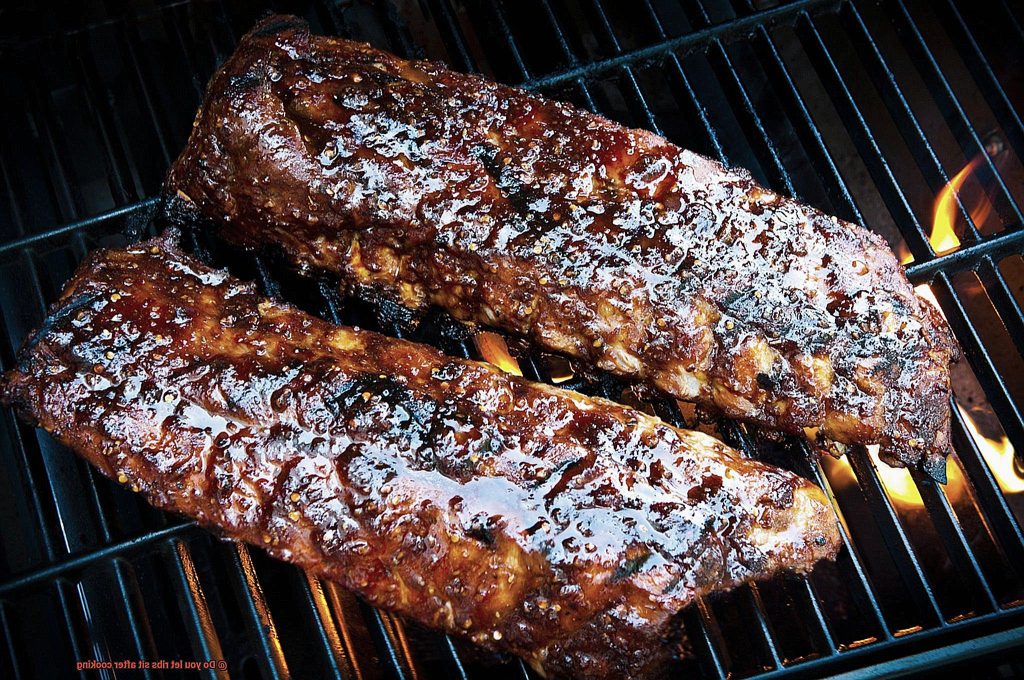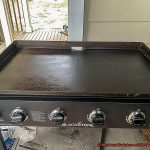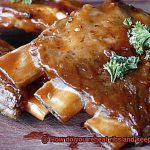Is there anything better than sinking your teeth into a succulent, juicy rack of ribs? Whether you prefer them slathered in a sweet and smoky sauce or with a spicy kick, ribs are an essential part of any barbecue feast. But what about the cooking process? Do you let your ribs sit after they come off the grill?
It’s a question that sparks debate among grill masters. Some swear by letting their meat rest for a while before serving, while others think it’s unnecessary. So, we decided to dig deeper and explore the pros and cons of letting your ribs sit after cooking.
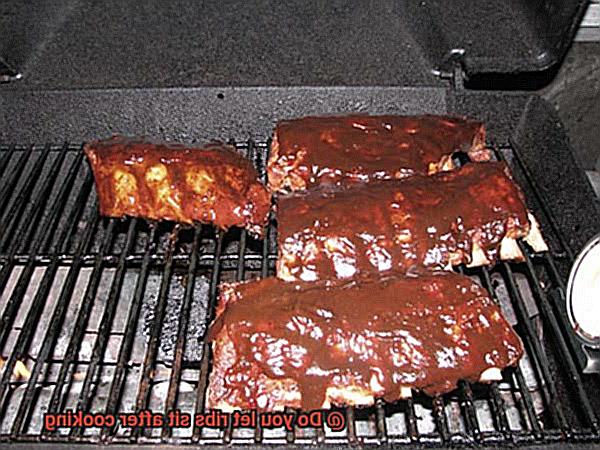
We’ll cover everything from how carryover cooking affects the texture of your meat to why heat distribution is crucial. Plus, we’ll delve into why letting your ribs rest can help retain optimal juiciness.
If you’re on a mission to perfect your rib game and want to know whether or not to let them sit after cooking, keep reading. By the end of this post, you’ll have all the information you need to make an informed decision about this critical step in the barbecue process.
Contents
What Does Letting Ribs Sit After Cooking Mean?
Then it’s time to learn about the crucial step of letting ribs sit after cooking.
Letting ribs sit after cooking involves removing them from the heat source and allowing them to rest for a few minutes before slicing and serving. This simple step can make a huge difference in the final product, resulting in tender, juicy meat that will have your guests begging for more.
The main reason for letting ribs sit after cooking is to allow the juices within the meat to redistribute evenly. When meat is cooked, the heat causes the juices to move towards the center of the cut. If you slice into the meat too soon after cooking, those juices will escape, leaving you with dry and tough meat. By letting your ribs rest, these juices have time to redistribute throughout the meat, resulting in a more succulent and flavorful final product.
In addition, resting your ribs allows the internal temperature of the meat to even out. When you remove meat from a heat source, the outer layers will continue to cook due to residual heat. If you slice into the meat too soon, you may end up with an overcooked exterior and an undercooked interior. Letting your meat rest for a few minutes allows this temperature differential to even out, resulting in a more consistent texture throughout the meat.
It’s important to note that different cuts of meat require different resting times. For example, a thin cut of steak may only need to rest for 5-10 minutes, while a large roast may require 30-40 minutes of resting time. Ribs typically require 10-15 minutes of resting time before slicing and serving.
Why Should You Let Your Ribs Rest After Cooking?
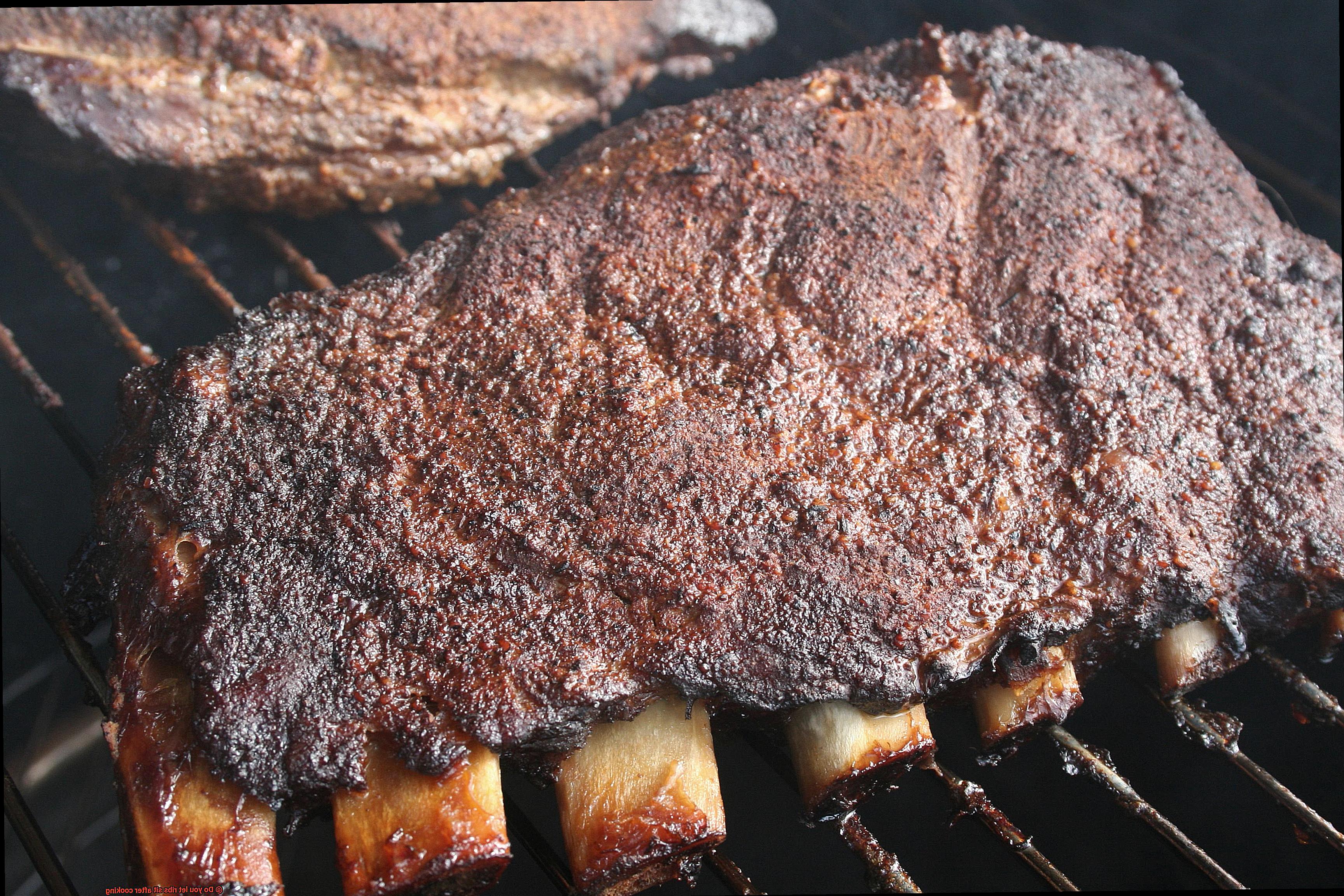
The tantalizing aroma of freshly barbecued ribs is enough to make anyone’s mouth water. But before you sink your teeth into these succulent meaty delights, there’s a crucial step that should not be overlooked – letting your ribs rest after cooking.
Sure, it might be tempting to dive in right away, but taking a few minutes to let your ribs rest can take your meal from good to great. Here are some compelling reasons why you should let your ribs rest after cooking:
Firstly, resting allows the juices to redistribute throughout the meat. When cooking on the grill, the heat causes the juices to accumulate in certain areas. By allowing your ribs to rest for just 5-10 minutes after cooking, the juices have time to evenly distribute throughout the meat again, ensuring each bite is moist and packed with flavor.
Secondly, resting makes your ribs more tender. Cutting into your meat immediately after cooking can cause it to lose its juices and become dry and tough. Allowing your ribs to rest gives the proteins in the meat time to relax again, resulting in a mouthwatering experience that melts in your mouth.
But wait, there’s more. Resting your ribs also makes them easier to handle. Taking your ribs off the grill means they are hot and may be difficult to handle without burning your hands or dropping them. By letting them rest for a few minutes, not only do you have time to prepare your sides or sauces, but the ribs also cool down slightly, making them easier to handle and cut into.
How Long Should You Let Your Ribs Rest?
Before you start chowing down, there’s one crucial step you can’t skip – letting your ribs rest. As an expert on all things barbecue, I’m here to tell you just how long you should let your ribs rest and what factors can affect the resting time.
When it comes to cooking ribs, letting them rest after they’re done cooking is a crucial step. This allows the juices to redistribute throughout the meat, resulting in a more tender and flavorful final product. But how long should you let your ribs rest?
The general rule of thumb is to let your ribs rest for at least 10-15 minutes before cutting into them. This allows for the juices to settle and the meat to firm up slightly, making it easier to slice without tearing or shredding. However, die-hard pitmasters and grill enthusiasts swear by letting their ribs rest for up to an hour or more.
The length of time you let your ribs rest can also depend on the type of ribs you are cooking. Baby back ribs may only need a shorter rest period as they are smaller and cook faster than spare ribs or beef ribs. So, if you’re grilling up some baby backs, you may want to let them rest for only 10-15 minutes. However, if you’re cooking up a gigantic rack of beef ribs, it might be wise to let them rest for a bit longer.
In addition to rib types, the cooking method can affect the resting time. If you’ve wrapped your ribs in foil or butcher paper during the cooking process (also known as the “Texas crutch”), they may need less time to rest as the foil helps retain moisture in the meat.
But wait. There’s an important caveat – while resting your ribs is crucial for achieving optimal tenderness and flavor, it’s also important not to let them rest for too long. Otherwise, they may become cold and lose heat. It’s best to aim for a minimum of 10-15 minutes but no longer than an hour.
Tips for Perfectly Cooked and Tender Ribs
Ribs are one of the most popular dishes in the world, and for good reason. There’s nothing quite like a juicy, flavorful rib that falls off the bone. However, getting your ribs just right can be a challenge. To help you achieve perfectly cooked and tender ribs every time, here are some tips to consider.
Rest Your Ribs
One of the most important steps in cooking ribs is letting them rest after they come off the grill or out of the oven. This allows the meat to finish cooking and absorb flavors, resulting in juicy, tender ribs that will impress your guests. Resist the temptation to cut into your ribs as soon as they’re done cooking, and instead let them sit for at least 10-15 minutes before serving.
Cook Low and Slow
When it comes to cooking ribs, low and slow is the way to go. This means cooking them at a low temperature for a long period of time. This allows the connective tissue in the meat to break down slowly, resulting in fall-off-the-bone tender meat that’s bursting with flavor.
Whether you cook your ribs on a grill, smoker or in the oven, maintaining a low temperature is key. Aim for a temperature between 225-250°F, and cook your ribs for several hours until they’re fully cooked and tender.
Season Generously
To enhance the flavor of your ribs even further, season them generously with your favorite rub or marinade. A good rub should have a balance of sweet and savory flavors that complement the meat perfectly, while a marinade can add moisture to the meat as well as flavor.
Don’t be afraid to experiment with different seasonings until you find a combination that you love.
Brush on Sauce
During the resting period, you can brush on any additional sauces or glazes to enhance the flavor of your ribs even further. This will add a layer of complexity to the taste of your meat, making it more flavorful and satisfying. Just be sure to let the sauce set for a few minutes before cutting into the meat.
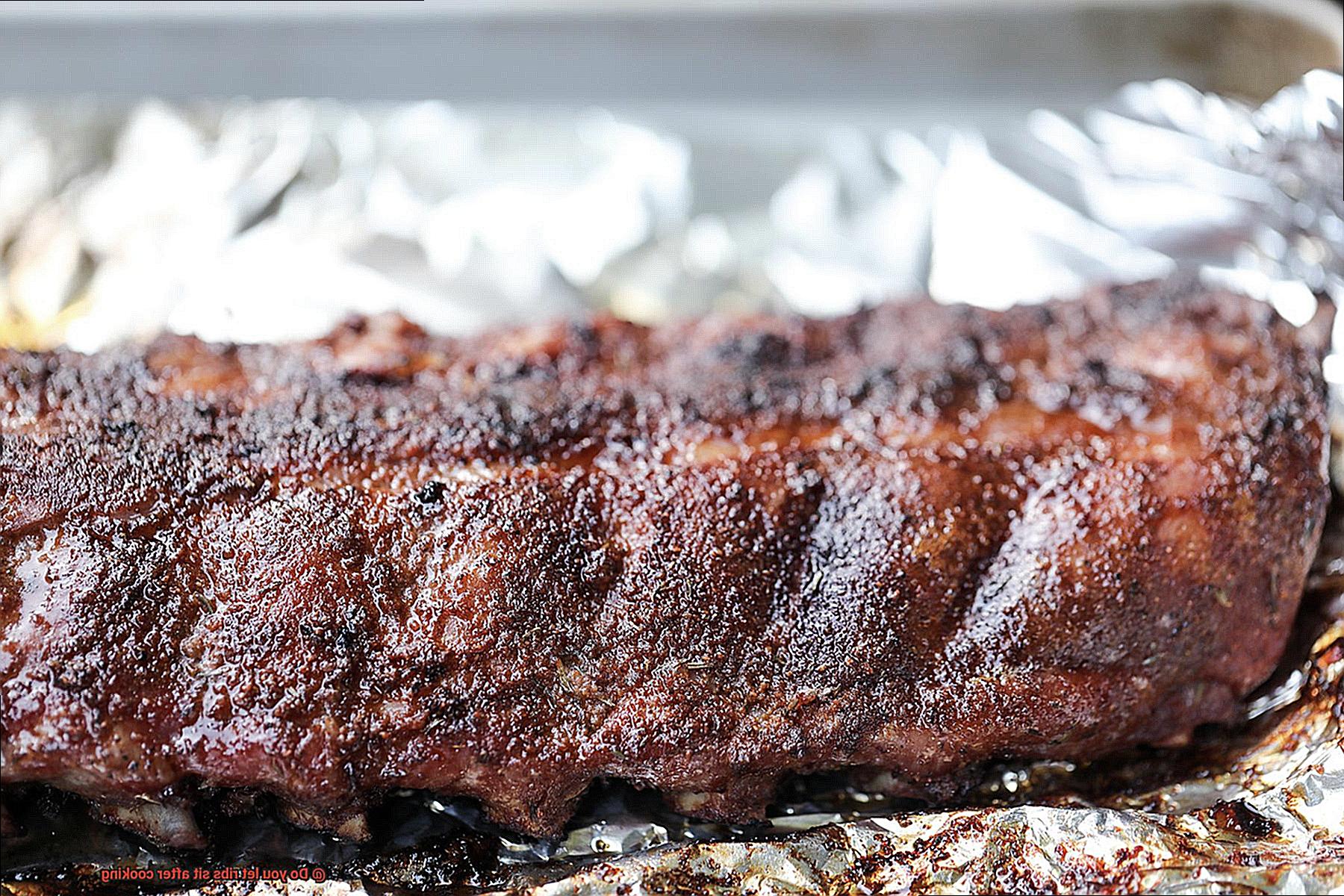
Serve with Sides
Ribs are not complete without some delicious sides to complement them. Whether you choose coleslaw, cornbread, baked beans, or any other side dish that you prefer, make sure that it matches the flavor profile of your ribs. This will ensure that all the flavors blend together perfectly.
Benefits of Allowing Your Ribs to Rest After Cooking
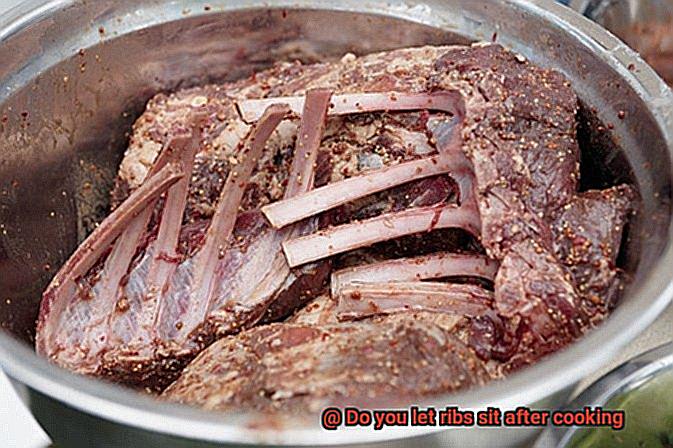
Let’s talk about the ultimate crowd-pleaser when it comes to BBQ – the mouth-watering, juicy, and tender ribs. Cooking ribs is an art, and if you want to achieve perfection, you need to know the importance of letting them rest after cooking.
Firstly, resting your ribs after cooking ensures that they are juicy and tender. While cooking meat, heat causes the juices to be pushed towards the center of the meat, leaving it dry. However, by allowing your ribs to rest, the juices have time to redistribute evenly throughout the meat, making it moist and flavorful.
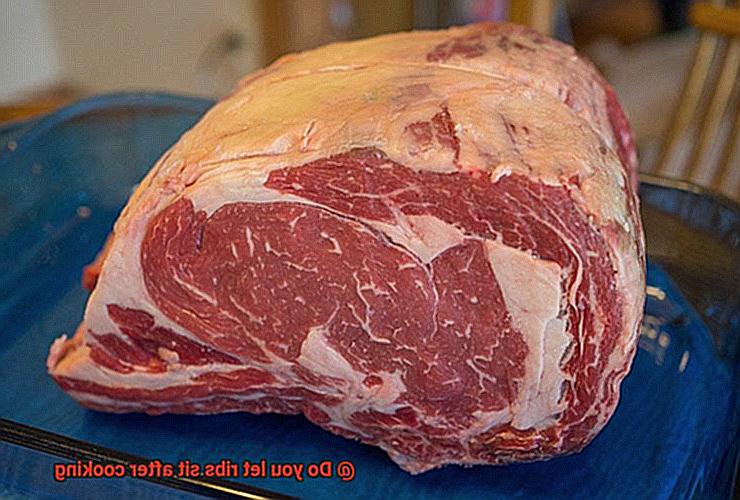
Additionally, letting your ribs rest after cooking allows them to finish cooking without overcooking. The residual heat continues to cook the meat for a few minutes even after you remove it from the heat source. By giving them time to rest, you’re ensuring that your ribs are cooked perfectly every time – not undercooked or overcooked.
Resting your ribs after cooking also makes them easier to handle and cut. Hot ribs can be delicate and fall apart easily, making them challenging to handle. By resting them for a few minutes, they cool down slightly, making them more manageable to slice and serve without falling apart.
Last but not least, allowing your ribs to rest after cooking enhances their flavor. The juices that have redistributed throughout the meat create a more savory rib that will make your taste buds dance with joy. The enhanced flavor will add more depth and satisfaction to your meal.
Common Mistakes When Letting Ribs Rest
Then, you already know that letting your ribs rest after cooking is a crucial step. But did you know that there are some mistakes that people commonly make when letting their ribs rest? Don’t worry, I’m here to share with you some expert tips on how to avoid these pitfalls and achieve rib perfection every time.
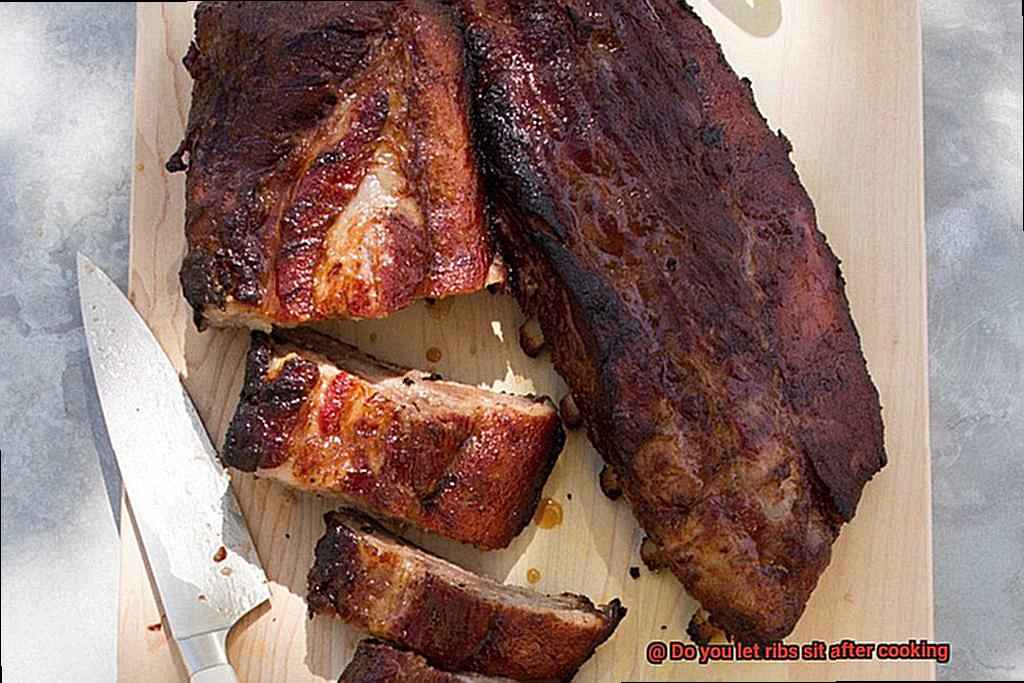
One of the most common mistakes people make is not giving their ribs enough time to rest. It may be tempting to dig in immediately, but patience is key. Allowing your ribs to rest for at least 10-15 minutes will allow the juices to redistribute throughout the meat, resulting in a more tender and flavorful end product. Cutting into your ribs too soon can cause the juices to spill out, leaving the meat dry and tough.
Another mistake to avoid is improper wrapping during resting. Wrapping your ribs in foil or butcher paper helps prevent the meat from drying out, but it’s important to wrap them correctly. Wrapping them too tightly can lead to uneven moisture distribution, while leaving them unwrapped can result in dry and tough meat. So make sure to wrap your ribs properly for optimal results.
Lastly, failing to keep your ribs warm during resting can also be a mistake. Leaving your ribs uncovered or placing them in a cold environment can cause them to lose heat quickly, resulting in less enjoyable meat. To prevent this from happening, it’s recommended to keep your wrapped ribs in a warm place or even place them in a cooler with towels to insulate them.
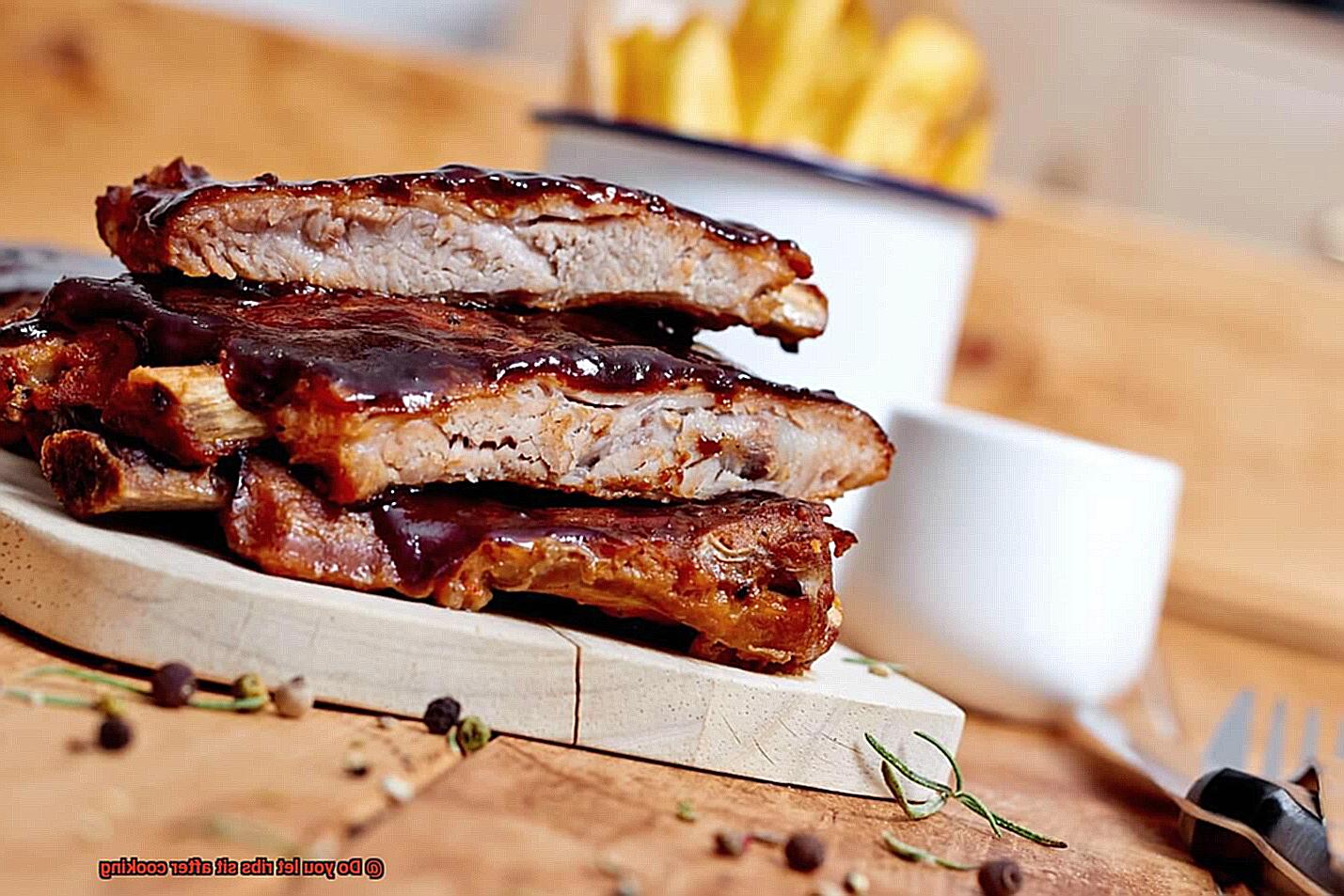
To summarize, here are some key takeaways for avoiding common mistakes when letting your ribs rest:
- Patience is key – let your ribs rest for at least 10-15 minutes before cutting into them
- Wrap your ribs properly to prevent uneven moisture distribution and dryness/toughness
- Keep your wrapped ribs warm during resting
The Best Way to Reheat Cooked Ribs
If you’re craving some mouth-watering ribs but don’t want to go through the hassle of cooking them again, reheating cooked ribs is your best bet. As an expert in this field, I recommend using a low and slow method to reheat your already cooked ribs. This method will help maintain the flavor and texture of the meat without making it tough or dry.
Here are some sub-topics that will guide you through the process of reheating cooked ribs:
Oven Reheating Method:
Preheat your oven to 250°F and place your cooked ribs on a baking sheet. Cover them with foil to prevent them from drying out and bake for about 20-30 minutes. To add more moisture, place a pan of water in the oven to create steam.
Grill Reheating Method:
Heat up your grill to medium heat. Brush your cooked ribs with a bit of oil to prevent sticking and cook for about 10-15 minutes, flipping them occasionally. Add moisture by spritzing the ribs with apple juice or another liquid every once in a while.
Resting Time:
After reheating your ribs, let them sit for a few minutes before serving. This will allow the juices to redistribute throughout the meat, making it more flavorful and tender.
One-time Reheating Only:
Reheating ribs more than once can lead to bacterial growth and foodborne illness. So, remember not to reheat your ribs more than once.
RffS7PIt0pY” >
Conclusion
In summary, taking the time to let your ribs rest after cooking is a crucial step in achieving mouth-watering meat that is both juicy and tender. By allowing the juices to redistribute evenly throughout the meat and for the internal temperature to even out, each bite will be bursting with flavor.
The standard rule of thumb is to rest your ribs for at least 10-15 minutes before slicing them up, but this can vary depending on factors such as the type of ribs and cooking method used. Not only does letting your ribs rest make them easier to handle and cut, but it also enhances their overall taste profile.
However, there are some common mistakes that people make when resting their ribs. One such mistake is not giving them enough time to rest or improperly wrapping them during resting. To avoid these pitfalls, it’s important to exercise patience and wrap your ribs correctly while keeping them warm throughout the resting period.
If you need to reheat cooked ribs, using a low and slow method such as oven or grill reheating is recommended. It’s important not to reheat your ribs more than once as doing so could lead to bacterial growth and foodborne illness.
By following these tips and tricks, you’ll be able to achieve rib perfection every time you cook.

